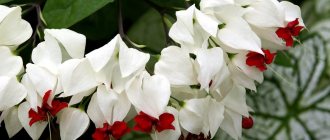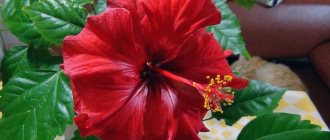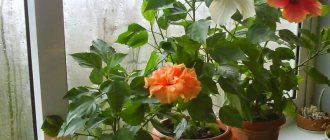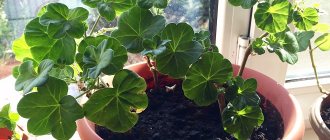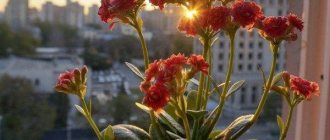How often does Decembrist bloom?
The Decembrist can be seen in many houses in Russia. During the cold winter, this tropical cactus is covered in numerous colorful flowers.
Most Decembrist varieties bloom once a year. The buds begin to appear at the end of October and begin to bloom in December. Schlumbergera can bloom for a long time, allowing you to admire the colorful flower throughout the winter.
If the Decembrist is kept in good conditions, a secondary flowering may begin in April, which is usually more abundant than the first.
There are rare varieties of Schlumbergera that bloom 3-4 times a year.
Why doesn't Decembrist bloom at home?
When purchasing a Decembrist, everyone expects it to bloom brightly and profusely. However, often it never begins to produce buds. There are many reasons why Schlumbergera does not bloom.
Incorrect temperature
Although the Decembrist's homeland is the tropics, he does not like extreme heat.
Under room conditions, the optimal temperature for growing crops is approximately 180C.
Constantly being warm, the plant itself feels good, but does not form buds. It is useful to remove it to a cooler place a few months before the Decembrist should begin to bloom.
Violation of the watering regime
Like all succulents, Decembrist does not like excess water. Any excess moisture can lead not only to the absence of flowers, but also to the death of the plant itself.
Excess moisture, accumulating in the fleshy leaves and soaking the root system, can cause rotting processes or provoke the development of various diseases.
Change of place
Decembrist is very sensitive to his location. For culture, it is important that the light source is constantly on one side.
If you move the pot from place to place or turn it around during the formation of buds, then Schlumbergera may shed all the existing buds and not begin to form new ones.
Incorrect lighting
It is no less sensitive to Schlumberger light than to water. Direct sunlight does not allow zygocactus to bloom, and in some cases leads to a complete absence of flowers.
In autumn and winter, it is preferable to keep the plant in a bright place in the western part of the apartment. When at rest, it is better to put the Decembrist in a shaded place.
Excessive application of fertilizers
Schlumbergers thrive in poor, sandy soil.
Applying large amounts of fertilizer leads to fattening. At the same time, green, fleshy leaves develop intensively, but the Decembrist does not want to bloom.
When planting, it is advisable to use neutral soil enriched with sand and peat.
Growing in deep pots
Decembrist has superficial roots and does not need a deep container. Water accumulates at the bottom of such pots, which interferes with the normal process of root respiration.
No rest period
The dormant period is very important for the formation of flower buds. If Schlumbergera is constantly kept in the same conditions, then it will most likely never bloom.
The first dormant period is needed after flowering, the second - before the buds open. At this time, the Decembrist should be placed in a darker and cooler place.
We hold events so that the Decembrist blooms
If you take good care of your Christmas tree, problems with flowering will disappear on their own. In order for the plant to delight you with a riot of colors in the winter cold, you need to follow several recommendations:
- keep the room cool, avoid drafts and frequent changes in temperature;
- provide enough moisture in the air;
- fertilize the plant in appropriate seasons;
- reduce watering during periods of rest and bud formation, and during flowering, moisten abundantly;
- After the buds appear, do not move or rearrange the vessel with the flower, give it rest.
Conditions for keeping the Decembrist, what it needs for flowering
By growing Decembrist in favorable conditions, you can easily make it bloom colorfully and for a long time. Failure to comply with at least one factor can weaken the formation of buds.
Lighting
Schlumbergera is demanding on lighting conditions. Direct sunlight will not make it bloom and can even lead to the death of the plant itself.
Decembrist feels good on western or northern windows. It is important to provide bright but diffused sunlight throughout the day.
Air temperature
The temperature in the room where the Decembrist grows should differ in different phases of its development. After the last flowers fade, in spring and summer, the plant lives quietly at 240C.
Before blooming, in the autumn months it is advisable to place it in a cooler place where the temperature will not exceed 17-180C.
And during the formation of buds, it is better to move the pot to a warm place.
Indoor air humidity
In its natural environment, Decembrist grows in the tropics, in conditions of high humidity. The room must also be protected from dry air.
A sign that a flower lacks moisture is wrinkling and loss of elasticity of young leaves.
It is important to regularly spray Schlumbergera with a spray bottle. Do not place the pot near heating systems. It’s good if there is a vessel with water nearby.
Watering
Abundant and regular watering provides succulents with the moisture they need. However, it should not be frequent.
It is important not to let water accumulate even in small quantities. It is recommended to water Schlumbergera when the top layer of soil dries 4-5 cm.
Decembrist flower – description, photo
The genus Schlumbergera is represented by epiphytic cacti with a densely branched shrub habit. The life form of plants involves living on large woody representatives of the tropical forest. Epiphytes do not harm trees; they use them only as physical support, i.e. they are not parasites.
Important! Schlumbergera is often confused with Ripsalidopsis. Such a mistake by flower growers can result in not only a lack of buds for the flower, but also a threat to life, because caring for plants is somewhat different.
Zygocactus, unlike its prickly desert counterparts, has adapted to living in the tropical zone. The humid microclimate of the Brazilian rainforest forced Schlumbergera to move into trees, where not much moisture accumulates. The agricultural technology of ordinary cacti and Schlumbergera is strikingly different.
Epiphytes live at altitudes of up to 2.8 km and have aerial roots to obtain moisture and nutrients from the environment. The plant’s own root system is poorly developed, so zygocacti do not need a lot of space for development. Europeans became acquainted with exotics at the beginning of the 19th century. Collector of tropical flora A. Cunningham brought the plant from another expedition. The name of the genus was given in honor of the famous French botanist who was engaged in breeding succulents and cacti - Frederic Schlumberger.
Decembrist is a small lush bush up to 40 cm high. Its shoots are divided into small segments, similar in shape to small fleshy leaves, flattened into a flat cake. The flat branches are devoid of thorns, but have small jagged edges. Cladodes (segments) are sections of the stem, but perform the function of leaves.
This is interesting! There are many positive signs associated with the flowering of the Christmas tree. Beliefs say that the owner of the blooming exotic will experience changes for the better.
Decembrist blooms after a period of dormancy and is characterized by abundance. Zygocactus flowers are very attractive. What gives them a special charm is their double-row bell-shaped corolla, consisting of elongated oval petals with a pointed tip and long stamens. Although wild species have petals colored pink, breeders have significantly expanded the range, adding white, red, purple, orange and yellow shades. Flowers are formed on the crown segments of the shoot. Thanks to selection, flower growers can replenish the collection of zygocacti with varieties with a double or two-color corolla.
The main method of propagation is rooting of stem parts consisting of 2-4 segments. Seed propagation is used for breeding purposes. The fruits of the plant are berries containing small black seeds. With proper care, homemade exotics will illuminate your home with bright colors every winter for 20-25 years. The only drawback of the old individual is lignification of the lower part of the stem, but during flowering it is completely invisible.
The genus Schlumbergera includes about a dozen species, of which only three are common in culture:
- truncated;
- Gertner;
- Buckley.
Varieties differ in the shape and size of the segments, and the length of the flower. The truncated variety consists of cladodes up to 4.5 cm long and up to 2.5 cm wide. Each segment is equipped with 2-4 symmetrical denticles along the edges, the crown is truncated. The corollas of the flowers are of a bright crimson hue, reaching a length of 8 cm. The petals are gracefully bent back, painted in white, pink, and purple shades.
On a note! The drooping shoots of Schlumbergera make the flower ideal for growing in hanging pots.
The Gertner variety stands out among its relatives due to its larger dimensions. The bush can grow to a height of 50-60 cm, and the length of the segments can reach 6-7 cm. Double-row bell-shaped corollas consist of narrow pointed petals of red-orange color.
Buckley's species does not have such pronounced denticles on the segments as the truncated one, but there are still small projections. Cladodes are colored in light green tones. Symmetrical double bells are often pink-violet in color.
A lot of hybrid exotic varieties have been bred. They differ from the original in the size of the corolla and cladodes, and the color of the petals. Hybrids are more resistant to fungal diseases, unpretentious, and highly decorative.
How to make Decembrist bloom, what to do
If a plant doesn't bloom year after year, don't give up. There are ways you can make Schlumbergera bloom.
Climate change at rest
If the Decembrist misses the budding phase in winter, then several months before the next expected flowering you need to put it in a cool place with a temperature no higher than 150C.
Watering must be reduced. In the fall, you need to return the Schlumbergera to its usual place and provide it with enough water and good lighting.
This will cause the Schlumbergera, which has returned to its normal life cycle, to bloom.
Schlumbergera rejuvenation
Decembrist may stop blooming due to old age. In this case, the bush requires renewal pruning. It is usually carried out in the spring.
This will also make the Decembrist bloom.
Carefully cut off 1-3 outer segments from all branches. You also need to remove diseased, dried out shoots that thicken the central part.
REFERENCE. Torn leaves can be rooted in a glass of water or by deepening them into the soil.
Transfer
One of the reasons why Schlumbergera does not bloom may be inappropriate soil used during planting.
It is better to replant Decembrist into a ready-made soil mixture for cacti. If desired, you can prepare it yourself. To do this, you need to add sand and peat in equal proportions to the garden soil. Changing the habitat will also cause Schlumbergera to bloom.
ON A NOTE. Old Decembrists respond well to the application of mineral fertilizers.
How to speed up its flowering in winter and make it bloom profusely?
In order for the Christmas tree to delight you with flowering, you need to properly care for it.
With the onset of autumn, it becomes colder outside than at home. You need to move the Schlumbergera to a balcony or veranda for a month and avoid watering. With the onset of cold weather and frost, you need to return the flower indoors and provide it with lighting for 10 hours a day. Decembrist needs to be watered 2-3 times every 7 days. In less than 2 months the first inflorescences will appear.
To speed up the flowering of the Decembrist, you should follow the basic instructions:
- in a cool room with high humidity the process takes longer;
- faded flowers should be removed immediately;
- it is necessary to update the soil with a substrate for succulents.
Attention ! In order for a Christmas tree to have a large number of flowers, it needs to be stimulated with fertilizing. Phosphorus and potassium will help the Decembrist bloom lushly. Therefore, in advance, starting in April, it is necessary to pamper the plant with minerals once a month.
In the summer, Schlumbergera actively grows and spends a lot of energy on it, so it is advisable to increase the amount of fertilizer and feed the flower 2 times a month. In November, fertilizing should be suspended.
How to care for Decembrist at different times of the year, table by month
Decembrist is an unpretentious flower that can live in almost any conditions. However, it may not bloom due to many factors.
In order for Schlumbergera to bloom, it can be forced to do so with the help of emergency measures, or you can simply provide special conditions at different times of the year.
| Month | Period | Temperature (0c) | Watering | Top dressing | Lighting |
| September – early November | peace 1 | 15-18 | 1 time/2 weeks | disposable nitrogen-containing | 12 hours/day blackout (3 weeks) |
| end of November - January | formation of buds; bloom | 17-20 | 1 time/week | 1 time/2 weeks mineral | full, without direct sunlight |
| February March | peace 2 | 13-16 | 1 time/2 weeks | mineral | scattered |
| April - August | vegetation | 25-27 | regular | 1 time/month | full, without direct sunlight |
Caring for a flower during flowering
The blooming Decembrist requires special attention. By providing favorable conditions, Schlumbergera can be made to bloom for several months.
- Flowers on Schlumbergera bloom gradually. It is important to immediately remove faded specimens from the flower stalks.
- During flowering, the plant is especially sensitive to air humidity. It is important to constantly moisten the room; you can place a saucer or vase with water nearby. Spraying is not advisable; water can get on the buds and cause them to fall off.
- During this period, you need to provide the Schlumbergera with good watering. Abundant and regular, it should not be frequent.
- When the plant is blooming, do not move, rearrange or rotate the pot.
By following simple rules, you can admire the bright colors of Schlumberger throughout the winter.
What is the reason if Schlumbergera does not form buds well?
The juicy greens of the Decembrist look impressive. But, of course, the main feature is the flowering of Schlumbergera. If this process is not the same as usual: the plant has stopped blooming or there are few buds, they are small and quickly fall off, then such phenomena indicate the presence of problems with the health of the flower.
Problems with the root system of an indoor flower
Zygocactus has a weak root system , so the slightest lack of care puts it at risk.
This often happens due to excess liquid in the pot or wetting with cold water. Symptoms:
- loss of segments;
- soil acidification;
- soggy flowers;
- the appearance of black spots on the buds.
If the roots become diseased, it is necessary to urgently inspect them, remove rotten areas and replant them in new soil.
Be sure to treat the plant with systemic fungicides. Otherwise, such a serious problem threatens the loss of your pet.
Nutritional deficiency
The Decembrist is fed throughout the year, with the exception of the dormant period . This is done by mineral fertilizers. If the plant has not been replanted for a long time, then the soil is accordingly depleted. It does not have enough nutrients for full development and flowering. Appearance also indicates nutritional deficiency:
- pale green color;
- lack of growth;
- deformation of young shoots;
- falling buds and drying out of the ovaries (read about why the Decembrist drops buds and how to fix this problem here).
In this case, you should feed the soil with fertilizers containing nitrogen, potassium, and phosphorus .
Why does the Christmas tree sometimes not grow for a long time or grow poorly or weakly? This could be due to:
- incorrect transplantation;
- unsuitable or poor substrate composition;
- fungal diseases;
- pest attacks;
- bad light;
- inappropriate irrigation system.
The main thing is to diagnose the cause in time and take action . Then the flower will grow again.
What to do when buds appear so that they bloom and do not fall off
During the budding phase, you may encounter the fact that they fall off without blooming. Following a few rules will help avoid this situation.
- It is important to remember that under no circumstances should you move the Decembrist to another place or turn the pot.
- The plant should be protected from direct sunlight, which can burn the delicate buds.
- It is necessary to prevent water from getting on the buds.
- It is advisable to water after the top layer of soil has dried.
What to do after the flower has faded
After the Decembrist has flowered, it must be properly prepared for the dormant period.
- A month after flowering, you can carry out rejuvenating pruning by removing old and dried shoots.
- It is useful to give the green part of the plant a warm shower. It is important to protect the soil from the penetration of excess moisture with a film.
- Watering must be gradually reduced.
- Creating a comfortable temperature for relaxation.
ON A NOTE. Such actions help the plant recover and gain strength for the new season.
Zygocactus dormant period
From August, zygocactus begins to prepare for dormancy. Feeding and watering are gradually reduced and completely stopped by September. At this time, the flower must be provided with a constant temperature of no higher than 17 °C. or keep it outside, covered from the rain. And already in October, bring it into a room with a temperature of 10 °C.
There are several tricks on how to achieve such indicators in an apartment without harming other plants.
- Leave the flower under the open window.
- Separate part of the window with film or glass, creating a cool corner for the zygocactus.
- Place bottles of ice around the pots and change them as they heat up.
- The central heating radiators are under the windowsill, where the pot is worth covering with thick towels.
If the dormant period is maintained, then in November the awakening stage begins for the zygocactus. It's time to think about how to prepare and how to make the Decembrist bloom after the end of sleep. First of all, you need to choose a permanent location and not disturb the flower while tying buds. Gradually resume watering, add lighting and increase the air temperature. For uniform formation of ovaries, slightly rotate the tub around its axis, but do not rearrange it.
Tips and Tricks
Experienced flower growers use various tricks to care for the Decembrist to make it bloom long and profusely.
- Adding rotted manure to the soil during spring replanting makes it bloom more strongly.
- Decembrist can be protected from direct sunlight by hanging crops that need bright rays.
- Using thick curtains, you can protect the pot with Decembrist from heating devices.
- Containers with water located nearby provide the necessary air humidity.
Common mistakes
When caring for the Decembrist for the first time, it is important not to make mistakes that will prevent it from blooming. The main ones:
- fertilizing immediately after flowering;
- use for planting acidic soil;
- location of the flower on the south side of the room;
- keeping at high temperatures;
- lack of conditions for plant rest;
- water getting on leaves and buds when watering.
Eliminating these errors increases the likelihood that Schlumbergera will bloom next season.
Answers to frequently asked questions
When growing Decembrist, most of the questions that arise are related to flowering. Knowing the answers to some of them, you can easily make this ornamental crop bloom.
Why do you need to put Decembrist in a dark place during the dormant period?
Answer : Schlumbergera flower buds begin to form when it is in the dark for at least 12 hours during the day. This regime should be followed for 2-3 weeks.
What water is best to use for irrigation?
Answer : It is better to take settled or spring water. It is important that its temperature does not differ from room temperature.
How often should Schlumbergera be replanted?
Answer : It is recommended to replant as necessary, in accordance with the growth of the plant. Unscheduled replanting if the land is contaminated or severely depleted.
When is the best time to prune?
Answer : The terminal segments are cut off approximately a month after flowering. Usually this is March - April.
How long can Decembrist bloom?
Answer : Under favorable conditions, it begins to bloom in late November and can bloom until February.
How to make Decembrist bloom a second time?
Answer : To make Schlumbergera bloom again, you need to create the necessary conditions for this.
During flowering the plant became sick, is it possible to replant?
Answer : It is strictly not recommended to disturb the Decembrist during flowering. If the situation persists, then it is better to wait for a period of rest.
Prevention measures
In order to protect the Decembrist from problems associated with the lack of flowering, it is necessary:
- During the flowering period, additionally highlight the cactus.
- Do not rearrange, rotate, replant or propagate the plant during the flowering period.
- Make sure there are no sudden changes in temperature.
- Treat the pot with boiling water when replanting.
- Treat the roots of the plant with warm water and soap if problems are suspected.
- Disinfect new soil with potassium permanganate or calcination.
Did you know? A folk sign says: there are many buds on the Christmas tree.
—
get ready for a cold winter.
So, Decembrist is one of the most beautiful cacti, but you may not wait for the flowers to appear. The reason for this may be errors in the conditions of maintenance, the lack of opportunity for the cactus to rest, non-compliance with the requirements for transplantation, and the Christmas tree may also get sick. Therefore, for the sake of such beauty, its owners must try and establish the necessary conditions for the appearance of flowers.



